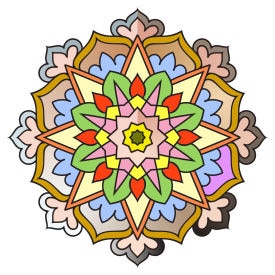There’s more to them than just a popular choice for colouring.
Mandalas, geometric designs and zen tangle are popular choices for adults who enjoy colouring. They all center around abstract designs to colour. They involve focus and concentration on just the image at hand thus helping the person doing the colouring to relax and just enjoy the process.
My attention was drawn to mandalas this week because I chose one to colour as part of my weekly giveaway.
 Recently I’ve been creating colouring books and have started giving gifts of colouring pages to my subscriber list at least weekly. You’re welcome to join in if you’d like and get this week’s image.
Recently I’ve been creating colouring books and have started giving gifts of colouring pages to my subscriber list at least weekly. You’re welcome to join in if you’d like and get this week’s image.
But, I don’t want to get off track from sharing what I’ve learned about mandalas.
What Makes a Mandala Different?
While mandalas can be fun to colour, their origins come from ancient times. The name is Sanskrit meaning circle. Which definitely explains why mandalas are contained in a circular shape.
Sanskrit is an ancient language most closely associated by Hindus as being used by their Celestial Gods. Sanskrit refers to something perfectly done to transcend and express emotion. It’s an extraordinarily complex language with a vast vocabulary. It’s widely used in Jainism, Buddhism and Sikhism.
In some ways it reminds me of Latin in Western languages having been the basis of so much of our current vocabulary. Latin usage has almost died out. We still find it in some places like on crests but few people speak it outside of those who study in academia. Unlike Latin though, Sanskrit is not widely spoken but about 14,000 still claimed it as their primary language during a recent census in India.
The Emerging Mandala
The first mandalas emerged from the Buddhist faith which developed around 600 B.C. The early Buddhist monks travelled the Silk Road spreading their faith and the mandalas throughout their travels. They soon started appearing in other religious practices.
In Hinduism and Buddhism the mandala is two words representing the universe — manda (essence)and la (container). Their circular designs symbolizes life as never ending and interconnected. Life is a spiritual journey within the individual viewer. We may not always see our pull to explore our inner world as spiritual but no matter how you see it, the principle holds. Each person must understand the unity in the cosmos and then find their place within it
Mandala designs are often used as a meditation instrument and symbols of prayer. These practices mostly came from China, Japan and Tibet. The designs are meant to remove irritating thoughts and allow the creative mind to run free and relax. Thus their popularity for colouring choices.
In its most basic form a mandala is a circle contained within a square with a dot in the center forming a starting point. The circles are divided into sections around the starting point. They can be simple or complex.
In the Hindu and Buddhist faiths belief that entering the mandala and moving toward the center guides us through the cosmic process of transformation from suffering into one of joy and happiness.
Three Main Types of Mandalas
- Teaching — symbolic, each shape, line and colour represent an aspect of a philosophical or religious system.
- Healing — more intuitive, made for meditation to deliver wisdom, evoke feels of calm and channel focus
- Sand – used most by Buddhist monks and in Navajo cultures, they are intricate designs made from coloured sand to represent the impermanence of life.
The Symbolism Within the Mandala
If you take the time to explore the world of mandalas you’ll soon find they are as varied as the snowflakes which will soon be falling around some of us. They can range from the simple to very intricate. Within the intricacy there are common symbols.
They traditionally include wheels, trees, flowers, jewels to represent the Buddha’s mind in abstract. The center dot is considered the starting point and free of dimensions to shape the journey. The starting point is surrounded by lines and geometric patterns to represent the universe. The circle’s outer edge represents the cyclical nature of life.
Common Symbols Within the Mandala
- eight spoke wheel – represents perfect universe – eight-fold path of Buddhism – practices leading to liberation and rebirth
- bells – openness and emptying of the mind to invite in wisdom and clarity
- triangle – facing upward, action and energy; facing downward, creativity and pursuit of knowledge
- lotus flower – sacred Buddhist symbol depicting balance
- sun — common in modern mandalas – represents the universe and relates to life and energy
The Meaning of Their Colours
The use of colour in the mandalas also carry meaning.
- Red — strength, increased energy and passion
- Orange – creativity, intuition, transformation and self-awareness
- Pink – love, femininity and intuition
- Yellow – laughter, learning, happiness and wisdom
- Blue – inner peace, emotional healing and meditation
- Green – nurturing, physical healing, caring, psychic ability
- Purple – all things spiritual
- Black – individuality, deep thinking and mystery
I think I’ll be looking at mandalas a little bit different now. Maybe do some pondering on the symbolism I’m colouring.
SOURCES:
Invaluable
Ancient History Encyclopedia







